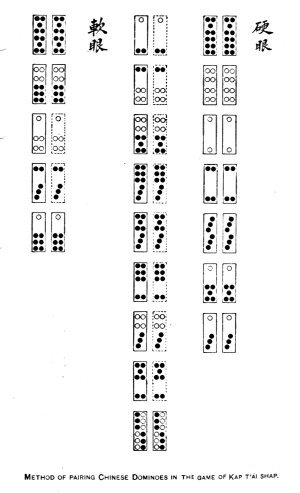
Kim tái shap, "to grasp many tens;" Ch'i tái chap, "to grasp many ones;" K'ap tái chap, "to complete many tens;" is played by any number of persons from 2 to 20 and upward, and is the favorite game with dominoes in the Chinese gambling houses in the United States. In many of these houses a large table covered with matting to deaden the sound is kept apart for this game. As there played, many sets of dominoes are used which are well mixed by the players and piled faces dawn, side by side, in piles 5 pieces high in a long stack upon the table.
One croupier, or one of the players, shakes 4 dice under a cup, and counts around to the right, commencing with the player on his right, up to the number thrown. The one at whom he stops becomes the first player. The top piece on the third pile from one end of the stack, with each alternate piece on the top up to the number of persons playing, less one, is now removed and placed in a pile at the other end of the stack. The first player takes 2 piles at the end and gets 10 pieces; the second player on his right takes the 2 next piles and gets 9 pieces, and so on, each player except the first getting 9 pieces.
In this game each piece in a set of dominoes may lie mated with a duplicate piece to form a pair called ngán, "eye." The ngán or eyes thus formed by the pieces on the left (Plate 6) are called ün ngán or "weak eyes," while those formed by the pieces on the right are called ngáng ngán, or "strong eyes." The object of the game is to get 10 pieces in each of which 2 are the same and form either an ün or ngáng ngán, and the others form 4 pairs, in each of which the sum of the spots is 10 or a multiple of 10, whence the name of the game. The piece 2‑4 is only counted as 3 in making up tens.
The players examine their pieces, and the first player if he has not drawn a wining hand, discards a piece which he throws face up on the table. The next player to the right may take this piece to complete a winning hand, or in exchange for a piece from his hand which he places face up on the table. He also draws a piece from the bottom of the exposed pile of the stack. If it does not complete a winning hand he may either throw it face up on the table, or keep it and discard a piece from his hand. The third player may now take one of the pieces on the table and draw one from the bottom of the exposed pile. The game proceeds in this way until one of the players gets 10 pieces, of which 2 form a ngán, and the others pairs on which the sum of the spots is 10 or a multiple of 10 and wins the game.
In gambling houses the stakes are placed in a box on the table at [Page 514] the commencement of each game, the players all contributing the same amount. Five per cent is at once taken from the box for the gambling house, and the remainder goes to the successful player.
K'ap shap, "to complete tens;" K'ím shap, "to grasp tens;" Shap tsai, "little tens." K'ap shap corresponds with the preceding game and is the name given to it when played by 2 persons. One set of dominoes are used and the pieces are arranged in a stack 4 high. The first player takes 8 and the second 7 pieces. The object of the game is to get 8 pieces, 2 of which form a ngán, or pair, and the others pairs on which the sum of the spots is 10 or a multiple of 10. In this game, as in k'ap t'ŕi shap, a winning hand is required to contain 1 ngán, or "eye." Slight variations from the manner here described occur in playing these games. The first player is frequently determined by drawing a domino and counting around, instead of by throwing dice.
Last update January 31, 2010